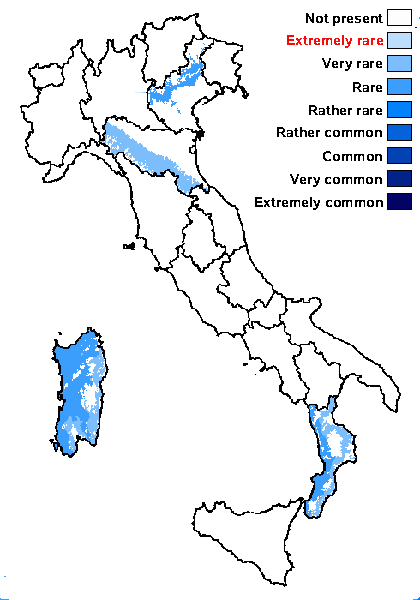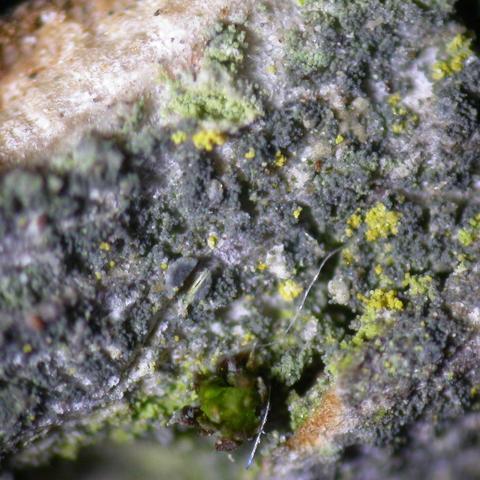Rinodina pityrea Ropin & H. Mayrhofer
Bibl. Lichenol., 58: 374, 1995.
Synonyms: Rinodina leprosa var. lecideina A. Massal.; Rinodina leprosa var. lecideina f. capniochroa A. Massal.; Rinodina leprosa var. lecideina f. fuliginea A. Massal.
Distribution: N - Ven (Lazzarin 2000, 2000b, Obermayer 2011), Emil (Ropin & Mayrhofer 1995, Fariselli & al. 2020). C - Sar (Ropin & Mayrhofer 1995). S - Cal (Nascimbene & al. 2021).
Description: Thallus crustose, endosubstratic or thinly episubstratic, sometimes poorly evident, dark grey, blue-grey or almost black, continuous to rimose, without a distinct prothallus, covered with irregular patches of blue-green to dark blue-grey, up to 30 µm wide blastidia. Apothecia rare, lecanorine, 0.3-0.7 mm across, broadly attached, with a black, flat to convex disc, and a thick, smooth to granulose-blastidiate thalline margin. Thalline exciple corticate, the cortex 15-30 µm thick, grey in outer part, colourless within, the pigmented part K+ violet; epithecium blue-grey or greenish grey, 10-15 µm high, K+ violet; hymenium colourless, (70-)80-90(-95) µm high; paraphyses simple or sparingly branched, the apical cell swollen, 3-5 µm wide; hypothecium colourless or yellowish, up to 70 µm high. Asci 8-spored, clavate, the K/I+ blue tholus penetrated by a faintly amyloid apical cushion with parallel or diverging flanks, the wall K/I-, surrounded by a K/I+ blue outer layer, Lecanora-type. Ascospores 1-septate, brown, (12.5-)14-21(-23.5) x (5-)7-9(-12) µm, thick- and double-walled, Tunicata-type, the wall strongly warted, with ontogeny of type A (apical wall thickening after septum formation). Pycnidia black. Conidia bacilliform, 5-7 x 1-2 µm. Photobiont chlorococcoid. Spot tests: thallus K-, C-, KC-, P-, but thick sections reacting fleeting K+, C+ and N+ violet. Chemistry: Sedifolia-grey pigment in thallus and epithecium. Note: a temperate species found on asbestos-cement and mortar, often on walls, more rarely on dust-impregnated bark; certainly more widespread, but easy to overlook, being often sterile.
Growth form: Crustose
Substrata: rocks
Photobiont: green algae other than Trentepohlia
Reproductive strategy: mainly asexual, by soredia, or soredia-like structures (e.g. blastidia)
Most common in areas with a humid-warm climate (e.g. most of Tyrrenian Italy)
Commonnes-rarity: (info)
Alpine belt: absent
Subalpine belt: absent
Oromediterranean belt: absent
Montane belt: absent
Submediterranean belt: very rare
Padanian area: absent
Humid submediterranean belt: rare
Humid mediterranean belt: rare
Dry mediterranean belt: absent

Predictive model
Growth form: Crustose
Substrata: rocks
Photobiont: green algae other than Trentepohlia
Reproductive strategy: mainly asexual, by soredia, or soredia-like structures (e.g. blastidia)
Most common in areas with a humid-warm climate (e.g. most of Tyrrenian Italy)
Commonnes-rarity: (info)
Alpine belt: absent
Subalpine belt: absent
Oromediterranean belt: absent
Montane belt: absent
Submediterranean belt: very rare
Padanian area: absent
Humid submediterranean belt: rare
Humid mediterranean belt: rare
Dry mediterranean belt: absent

Predictive model
 Index Fungorum
Index Fungorum
 GBIF
GBIF



